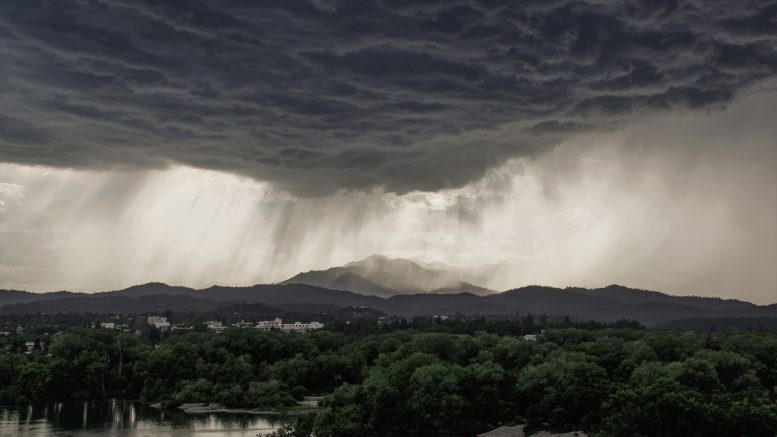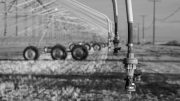Following the power and the money for the stories deeper than atmospheric rivers.
By Mark Schapiro, Capital & Main
This story is produced by the award-winning journalism nonprofit Capital & Main and co-published here with permission.
More than a dozen atmospheric rivers in succession prompted people to think: The California drought is over! The levees are breaking, hundreds of people are being displaced by the raging waters, rainfall is breaking records, and story after story suggest we are headed out of the decade-long drought that has devastated agriculture and wiped out the state’s water reserves. Whew. Dodged a bullet.
One part of that story is true. By mid-March, two-thirds of the state was officially out of drought.
But it’s temporary. The deluge shifted the focus, like the diversion in a magic trick.
Welcome to the simultaneous cataclysms of climate extremes: Drought leads to deluge. But deluge doesn’t get us out of the drought: The two are inextricably entwined, as further illustrated in this recent paper in Nature Water, which reports on the growing intensity of both droughts and floods.
You don’t have to look at the latest paper to understand that we’re now in a cycle of drought-deluge-drought-deluge.
The fact is, California is running out of water. We would need several successive years of deluges like the ones this year to make a serious dent in the impacts, over the past decade or so, of successive droughts, which have depleted the aquifers while the state has retained its attachment to the concrete-lined aqueduct and reservoir system that prevents soil absorption of all this excess water.
For journalists and everyone else, watch how those with power, money and a direct stake in the water system act. They’ve been staking out positions like animals around a watering hole — which, come to think of it, we all are. And they’re not acting like the drought is over; they’re maneuvering around a watering hole that’s shrinking.
One could, for example, look at water like a speculator, someone playing the odds in California water rights derivatives — a thriving trade now on the NASDAQ. These amount to bets on the price of water, which is largely shaped by supply. Speculators make money either way: By watching where the price and the money go, you can get a sense of where the water supply is headed. When supplies are tight, the price goes up; when supplies are abundant, it goes down. Water on the market works like, well, capitalism. Speculators can make money by correctly anticipating which way the supply is moving. And journalists can find a story either way, because the price signals where the real money thinks things are going.
A deluge is like going short on water, betting that the price will fall; too much supply, communities flood, reservoirs replenish (for a while). And a drought is like going long, betting on the rising price; not enough supply, communities and farmers buy emergency water. Both are at play. Watch the river flow; follow the money.
Here’s one way to do that: The NASDAQ-Veles California Water Index (NQH2O) tracks the average price of available surface and groundwater for sale in California. Over the last year, the lowest price was $775/acre-foot back in April of 2022, when there was a deluge of rain, a welcome, and temporary, respite from the drought. (An acre-foot is the amount of water it takes to fill an acre-sized field with a foot of water.) Then the price hit a high of $1,300 per acre-foot in September, a peak drought month also marked by horrific wildfires. Now, as of mid-March, after more than a dozen successive atmospheric rivers, the price has not plunged; it’s bobbing at about $986/acre-foot, which suggests that investors are not taking this flow of water from the heavens for granted. It’s a price that suggests: Things will tighten again.
Another way to look at it is through the eyes of industrial-scale farmers in the Central Valley. While most of us have been looking up to see what new deluges are headed our way from the rivers above our heads, farmers in the Central Valley, home to California’s multibillion dollar agriculture industry, have been looking down, at the underground aquifer that has long saved them from water oblivion. Not anymore: They’re facing serious cutbacks in the amount of water that can be sucked out of an exhausted underground aquifer they’ve been drawing on without limit for decades. The storms have done little to recharge the aquifer that at times provides as much as 40% of the water supply in the Valley.
One thing to watch for: How will the crop patterns shift in the Central Valley? The cultivation of almonds, the thirstiest of all food crops, expanded by 78% between 2010 and 2022; at least half of those dozen years were in periods of extreme drought. Almost 70% of those almonds are exported, according to the USDA — which amounts to exports of California water, to Europe, Japan, China and the Middle East, the primary almond export markets.
Back during the drought of 2014, then-Gov. Jerry Brown signed the Sustainable Groundwater Management Act (SGWMA), which requires, for the first time in California’s history, each of the dozens of water districts in the Central Valley to submit annual plans for reducing their groundwater access to levels ensuring sustainability by 2040. That means the amount of water withdrawn from the aquifer is equal to the amount that’s returned to it, mostly through absorption in the soil. In early March, the state Department of Water Resources rejected six of the districts’ groundwater reduction plans, which had been sculpted to benefit large landowners and did not take account of the rate of depletion.
Those reports are supposed to be publicly available, and will reveal how the districts themselves — often dominated by large landowners — are proposing to position themselves for water access, sometimes, as the state determined in those six cases, at the expense of smaller farmers and farmworker communities, many of whose wells went dry during the last drought. Will those wells refill after the deluge?
For anyone willing to wade through hours of hearings and documents from administrative courthouses and land records in obscure corners of the state, one can glean the perspective of the Metropolitan Water District of Southern California, which manages the water flow for some 18 million people in Los Angeles and surrounding communities. The MWD is in a pretty continuous panic about where L.A. will be getting its water in the coming years. In February, the MWD held a retreat for its board members to address the threats climate change presents to Southern California’s water supply.
“[F]rom increased heat to stronger storms to decreased snowpack, to changes in precipitation patterns … the time is now to start incorporating climate change into resource and financial planning,” declared one of the MWD officials in a recording of the meeting. “Heat, drought, wildfires, sea level rise, you name it, there’s a lot of things coming at the agency.” No one, over a nearly five-hour meeting, mentioned how the deluge — we were then on our ninth round of atmospheric rivers — was going to be the savior for Southern California’s water issues.
Every one of those factors is fertile ground for stories. Would California, for example, continue to be the one holdout on negotiating cuts to its water allocation from the Colorado River in talks with the six other states (Arizona, Nevada, Utah, New Mexico, Colorado and Wyoming) that rely on the Colorado if the deluges solved the state’s long-term water needs? Meanwhile, Lake Mead, a key reservoir in that system, and a key source for water in L.A., is at about 30% capacity and by next year could drop below 1,000 feet, the water level at which it becomes dysfunctional as a reservoir or power source for turbines, according to NOAA. That estimate was made in mid-February, which was about midway through our atmospheric river epidemic. There are few indications that Lake Mead will once again be a vital participant in supplying L.A. with water.
Water World
What’s really going on can be understood with two lessons about water. Lesson No. 1: There’s a fixed amount of water on Earth and circulating in our atmosphere. If rain is falling here, it’s not falling somewhere else. And if it’s falling here now, at these accelerating and unprecedentedly intense rates, scientists are clear that there’s a very good chance it won’t be falling here again for a while either.
Lesson No. 2: What goes up, as they say, must come down. But there’s another part of that equation when it comes to water: What comes down must go back up. California’s average annual temperature has risen at least 1.5 degrees Fahrenheit since the early ’70s and is on track to rise about 2 degrees more by 2040. The years 2000-21 represented the driest 22-year period in 1,200 years, according to a study published in the journal Nature Climate Change. The hotter it gets, the more water evaporates. All that moisture rises into a hotter atmosphere that can hold more of it. So when the rain comes, it doesn’t just dapple us with light sprinkles, it drops the heavier load of moisture that has been accumulating for a longer time. And then it takes a longer time to return to us as rain — thus, drought.
Water, who gets it and who doesn’t, is the story of our time. Like an atmospheric river, those stories will just keep on coming.
Copyright 2023 Capital & Main



Be the first to comment on "California’s drought is not over"